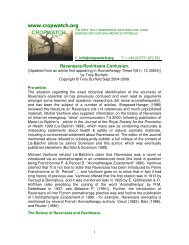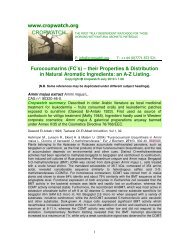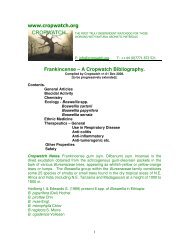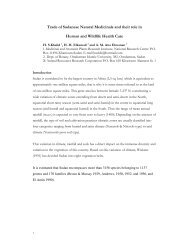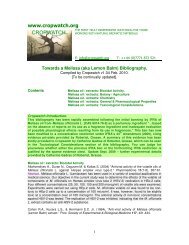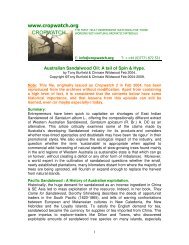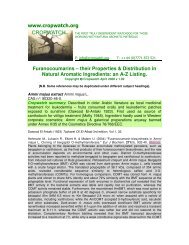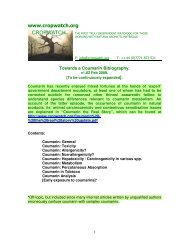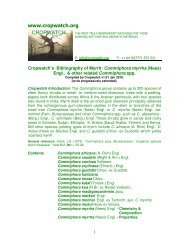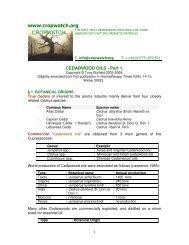Sandalwood Biblio - Cropwatch
Sandalwood Biblio - Cropwatch
Sandalwood Biblio - Cropwatch
You also want an ePaper? Increase the reach of your titles
YUMPU automatically turns print PDFs into web optimized ePapers that Google loves.
in association with Eucalyptus stands. It is suggested that the water-shedding properties of the<br />
granite exposures are less important to sustaining sandalwood than the presence of preferentially<br />
parasitised host species.<br />
George, A. S. (1984). “Santalum.” in Flora of Australia, vol. 22. Bureau of Flora and Fauna.<br />
Australian Government Publishing Service. Canberra, Australia.<br />
George, A.S 1996) “<strong>Sandalwood</strong>s and quandongs of Australia.” Australian Plants 13, 318-319<br />
Gearon V. (2000) at<br />
http://www.essentiallyoils.com/Newsletters/October_2000_Newsletter/october_2000_newsletter.h<br />
tml<br />
Gearon V. (2002) Aromatherapy Today 24, Dec 2002 p21<br />
Gowda D. (2008) “Detergents“Decline in the Supply of Natural <strong>Sandalwood</strong> oil: deforestation,<br />
adulteration and synthetics.” <strong>Sandalwood</strong> Conference 2008 at The Kimberley Grande,<br />
Kununurra, W. Australia 13-15 May 2008. <strong>Cropwatch</strong> Comments: Gowda maintains that in spite<br />
of the official figures, the current (2008) annual production of sandalwood is 3,000 - 4,000 tons<br />
and for sandalwood oil is 120-150 tons, of which 80 tons/annum of sandalwood oil is consumed<br />
by the domestic market. Gowda is employed by Karnataka Soaps & Detergents Ltd. (KSDL) once<br />
the largest producers of sandalwood oil E.I. Gowda informs us that sandalwood oil distillation<br />
commenced in 1916 in Mysore, and 2 years later the essential oil was incorporated into<br />
sandalwood soap by KSDL. Gowda lists polyethylene glycols, African sandalwood oil, castor oil<br />
and coconut oil amongst the adulterants of E.I. Sandalwod oil.<br />
Grant, W.J.R. & Buttrose, M.S. (1978) "Domestication of the quandong, Santalum<br />
acuminatum.”" Australian Plants 9, 316-318<br />
Harbaugh D. (2007) "A taxonomic revision of Australian northern sandalwood (Santalum<br />
lanceolatum, Santalaceae)." Australian Systematic Botany 20(5) 409–416. Abstract. A previously<br />
published molecular phylogenetic analysis of the sandalwood genus, Santalum L. (Santalaceae),<br />
identified that the Australian endemic northern sandalwood, S. lanceolatum R.Br., is not<br />
monophyletic and contains a distinct, yet cryptic, lineage within it as currently circumscribed. This<br />
study examines nuclear ribosomal gene sequences of additional specimens from across its<br />
geographic range, and 30 morphological characters, in order to revise the taxonomy of S.<br />
lanceolatum sensu lat. (s.l.) and the segregate species that should bear the name S. leptocladum<br />
Gand. Santalum lanceolatum sensu stricto (s.s.) is distributed in the humid to subhumid regions<br />
of northern Australia north of 20°S latitude, whereas S. leptocladum occurs in the arid and<br />
temperate regions of central and southern Australia. Putative interspecific hybrids were<br />
discovered in two localities, and may represent either natural or human-mediated hybridisation.<br />
The results of this study have major economic and conservation implications because S.<br />
lanceolatum s.s., which is known to have higher levels of fragrance compounds than S.<br />
leptocladum, has a much more restricted range than previously thought.<br />
Harbaugh D.T. (2008) "Polyploid and Hybrid Origins of Pacific Island <strong>Sandalwood</strong>s (Santalum,<br />
Santalaceae) Inferred from Low-Copy Nuclear and Flow Cytometry Data." Int. J Plant Sci.<br />
169(5), 677–685. Abstract. It has been argued that polyploids are better adapted than diploids for<br />
long-distance dispersal to and establishment on oceanic islands. To address this issue in a<br />
molecular phylogenetic framework, the extensive history of auto- and allopolyploidization in<br />
Santalum (Santalaceae), the sandalwood genus, was studied by sequencing the low-copy<br />
nuclear gene waxy and investigating the ploidy level of all 16 species. Ploidy level was estimated<br />
by measuring the C value (total amount of DNA per nucleus) using flow cytometry and calibrating<br />
it by known chromosome numbers and new root-tip chromosome counts of several taxa. Results<br />
indicate four ploidy levels in Santalum: diploid (n=10), tetraploid (n=20), hexaploid (n=30), and<br />
octoploid (n=40). The waxy phylogeny suggests that at least six independent polyploid events<br />
occurred in the history of Santalum: two allopolyploid events between distantly related species<br />
12





